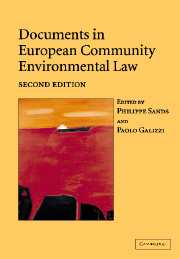Book contents
- Frontmatter
- Contents
- Preface
- PART I General principles of EC environmental law
- PART II European Community institutions and legislation
- 6 EC Treaty, as amended by the 1986 Single European Act, the 1992 Treaty on European Union, the 1997 Treaty of Amsterdam, the 2001 Treaty of Nice and the 2003 Act of Accession (selected articles)
- 7 Council Regulation (EEC) No 1210/90 of 7 May 1990 on the establishment of the European Environment Agency and the European environment information and observation network (OJ L 120 11.05.1990 p. 1)
- 7A Decision of 21 March 1997 on public access to European Environment Agency documents (OJ C 282 18.09.1997 p. 5)
- 8 Council Resolution of 7 October 1997 on the drafting, implementation and enforcement of Community environmental law (OJ C 321 22.10.1997 p. 1)
- PART III The relationship between environmental protection, financial assistance and free trade
- PART IV Procedural techniques of environmental protection
- PART V Protection of air quality
- PART VI Biodiversity and nature conservation
- PART VII Waste
- PART VIII Dangerous substances
- PART IX Water quality
7 - Council Regulation (EEC) No 1210/90 of 7 May 1990 on the establishment of the European Environment Agency and the European environment information and observation network (OJ L 120 11.05.1990 p. 1)
from PART II - European Community institutions and legislation
Published online by Cambridge University Press: 06 January 2010
- Frontmatter
- Contents
- Preface
- PART I General principles of EC environmental law
- PART II European Community institutions and legislation
- 6 EC Treaty, as amended by the 1986 Single European Act, the 1992 Treaty on European Union, the 1997 Treaty of Amsterdam, the 2001 Treaty of Nice and the 2003 Act of Accession (selected articles)
- 7 Council Regulation (EEC) No 1210/90 of 7 May 1990 on the establishment of the European Environment Agency and the European environment information and observation network (OJ L 120 11.05.1990 p. 1)
- 7A Decision of 21 March 1997 on public access to European Environment Agency documents (OJ C 282 18.09.1997 p. 5)
- 8 Council Resolution of 7 October 1997 on the drafting, implementation and enforcement of Community environmental law (OJ C 321 22.10.1997 p. 1)
- PART III The relationship between environmental protection, financial assistance and free trade
- PART IV Procedural techniques of environmental protection
- PART V Protection of air quality
- PART VI Biodiversity and nature conservation
- PART VII Waste
- PART VIII Dangerous substances
- PART IX Water quality
Summary
Editorial note
The European Environment Agency (EEA – www.eea.eu.int), which is based in Copenhagen, is aimed at providing the Community and the Member States with objective, reliable and comparable information at the European level to enable environmental protection measures to be taken, to assess the results of such measures, and to ensure that the public is properly informed about the state of the environment (Article 1). The Agency co-ordinates the European environment network and records, collates and assesses data on the state of the environment (Article 2). In addition, the Agency is to provide the Community and individual Member States with objective information necessary to frame and implement effective environmental policies; assist the monitoring of environmental measures; ensure that environmental data at the European level are comparable; promote the incorporation of European environmental information into international environmental monitoring programmes; publish a report on the state, trends and prospects for the environment; stimulate the development of environmental forecasting; etc. (Article 2(i) to (xiii)). Agency activity is to include assessment of the pressures on, and quality and sensitivity of, the environment, and to be directed to certain priority areas (Article 3(1) and (2)). The Agency is an autonomous legal entity run by a management board, an Executive Director and a scientific committee (Articles 7–10), which is open to countries that are not EC members (Article 19).
- Type
- Chapter
- Information
- Documents in European Community Environmental Law , pp. 168 - 180Publisher: Cambridge University PressPrint publication year: 2006
- 1
- Cited by



